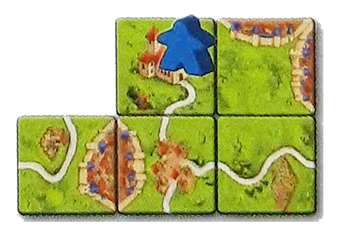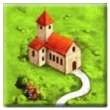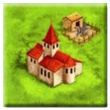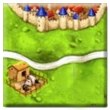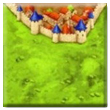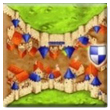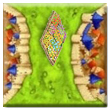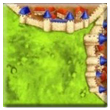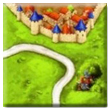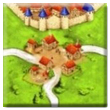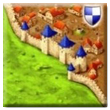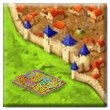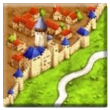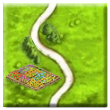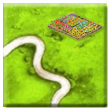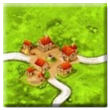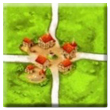Difference between revisions of "Demo Spiel/nl"
(Created page with "De tegels zijn uitgevoerd in de nieuwe stijl tekeningen die in 2014 geïntroduceerd werd met donkerdere stadsachtergronden.") |
(Created page with "== Korte spelregels ==") |
||
| Line 31: | Line 31: | ||
=== Spelverloop === | === Spelverloop === | ||
{{RulesPlacingTile|1=====|2=1. | {{RulesPlacingTile|1=====|2=1. Landtegel leggen| | ||
3= | 3=Eén voor één kies je een gedekte tegel, draait die om en legt die aan het speelveld. De regel is dat de randen altijd overeen moeten komen (weg aan weg, stad aan stad, weide aan weide). | ||
}} | }} | ||
Revision as of 00:45, 6 October 2022
Algemene informatie en opmerkingen
Promotionele mini-versie van Carcassonne inbegrepen bij de 25-jarig jubileum doos van 999 Games uit Template:Year nl. Hans im Glück heeft ook een Duitse editie uitgebracht.
Het spel is voor twee spelers en bevat 20 kleinere tegels en 8 kleinere meeples in twee kleuren. Alle spelregels van het basisspel zijn van toepassing, met uitzondering van de boeren. Een samenvatting van de spelregels is op de binnenkant van de doos afgedrukt (hieronder opgenomen). Er zit geen scoretableau bij.
De tegels zijn uitgevoerd in de nieuwe stijl tekeningen die in 2014 geïntroduceerd werd met donkerdere stadsachtergronden.
Speelmateriaal
- 20 kleinere landtegels
- 8 kleinere meeples in de kleuren rood en blauw (4 van elk)
Korte spelregels
Voorbereiding
Schud de landtegels en verdeel de meeples
Leg alle landtegels gedekt neer (grijze kant naar boven), meng ze door elkaar en leg ze zo neer dat je er allebei gemakkelijk bij kunt. Leg de tegel met de donkere achtergrond met de afbeelding naar boven in het midden van de tafel als starttegel. Je krijgt nu beiden 4 meeples in één kleur.
Aangezien er geen scoretableau bij zit, kan het zijn dat je papier en pen nodig hebt om de punten bij te houden.
Spelverloop
1. Landtegel leggen
Eén voor één kies je een gedekte tegel, draait die om en legt die aan het speelveld. De regel is dat de randen altijd overeen moeten komen (weg aan weg, stad aan stad, weide aan weide).
2. Placing a meeple
Once you have done this, you may place a meeple on a feature (road, city, monastery) of the tile you just placed. It is important that there is no other meeple of any color on the feature (a long road or a large city).
3. Scoring a completed feature
Whenever you have placed a tile and possibly a meeple, you check the landscape afterwards. If you have completed a feature with the last tile and there is a meeple on this feature, its owner will now score points. A feature is always completed when it can no longer be extended. You score following points for the completed features:
- Road: Each tile of the road scores 1 point.
- City: Each city tile receives 2 points.
- Monastery: It is completed when all 8 tiles around the monastery have been placed. It then scores 9 points.
Write these points down and then the player gets their meeple back (so it can be used again in the future).
End of the game, final score and winner
The game ends when all tiles have been placed. Now each player receives 1 point for each tile of their incomplete roads or cities, and 1 point for each tile of a monastery (including the monastery itself). The player with the most points wins the game.
Tegel verwijzing
Totale aantal tegels: 20
One of the tiles marked with "(S)" -tile number three- is the starting tile (with a dark back).
Several tiles have a small illustration on them. The letters in brackets show which illustration is on each tile:
Note: The small illustrations of a cowshed (not included in this edition), a pigsty and a donkey stable are collectively referred to as sheds or stables.





